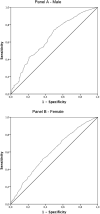Self-reported difficulty in walking 400 meters: the "red flag" for probable sarcopenia
- PMID: 35764941
- PMCID: PMC9238116
- DOI: 10.1186/s12877-022-03231-z
Self-reported difficulty in walking 400 meters: the "red flag" for probable sarcopenia
Abstract
Background: Sarcopenia is associated with adverse outcomes in older people. Several tools are recommended to assess muscle mass, muscle strength and physical performance, but are not always available in daily practice.
Objective: The aim of the present study is to evaluate if there is a correlation between the personal perception of physical performance (assessed through a question on personal functional status) and the effective presence of sarcopenia (according to the EWGSOP2 definition) using data from the Longevity Check-up 7 + project.
Design: Cross-sectional study.
Setting: The Longevity Check-up 7 + project is an ongoing study started in June 2015 and conducted in unconventional settings (i.e., exhibitions, malls, and health promotion campaigns).
Subjects: Candidate participants are eligible for enrollment if they are at least 18 years of age and provide written informed consent. For the present study subjects 65 years age old and older have been considered (n = 2901).
Methods: According to the most recent EWGSOP2 consensus definition, subjects were defined to be affected by probable sarcopenia when handgrip strength was less than 27 kg in male and less than 16 kg in female, respectively. Furthermore, a single question assessed the perceived health status regarding own physical performance: "Do you have any difficulty in walking 400 m?".
Results: Using the EWGSOP2 algorithm, 529 (18,9%) participants were identified as affected by probable sarcopenia with a significant higher prevalence among subjects with self-reported difficulty in walking 400 m compared to participant without any difficulty (33.6% versus 13.1%, respectively; p < 0.001). Relative to participants without self-reported difficulty, those subjects with self-reported difficulty in walking 400 m showed a significantly higher risk of sarcopenia (odds ratio [OR]: 3.34; 95% confidence interval [CI]: 2.75-4.07).
Conclusions: A single "Red Flag" question such as "Do you have any difficulty in walking 400 m?" should be considered as a recommended method for screening probable sarcopenia risk.
Keywords: 400 m walking test; Frailty; Muscle strength; Physical performance; Sarcopenia.
© 2022. The Author(s).
Conflict of interest statement
None.
Figures



References
Publication types
MeSH terms
LinkOut - more resources
Full Text Sources

